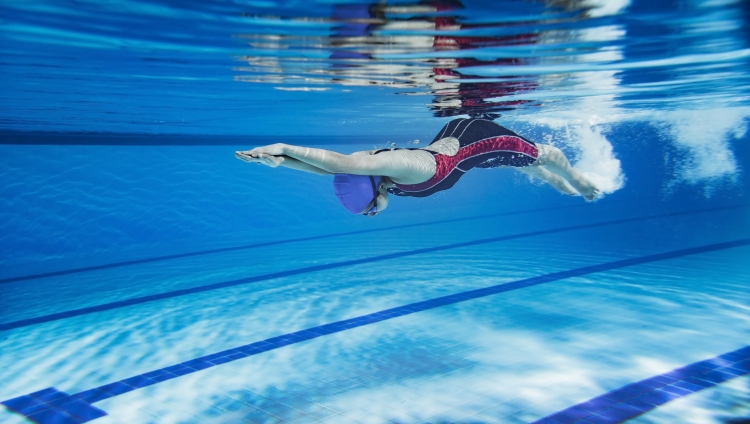Why is the Underwater Dolphin Kick Crucial for Speed in Swimming?
1. Reduced Water Resistance (Drag) 2. Powerful Propulsion from the Core 3. Uninterrupted Motion, Key Benefits of the Underwater Dolphin Kick for Competitive Swimming

Competitive swimming is a sport where fractions of a second can determine victory. Swimmers constantly refine their skills to gain a competitive edge, and mastering advanced techniques in swimming is essential for success.
Renowned for its power and efficiency, the underwater dolphin kick is often considered the fastest swimming technique when performed correctly. By reducing drag and maximizing propulsion, this technique has become a game-changer in competitive swimming events, especially during starts and turns. Explore why the underwater dolphin kick is vital for speed, how it works, and how swimmers can master it to improve performance in the pool.
What Is the Underwater Dolphin Kick?
The underwater dolphin kick is a streamlined kicking motion performed while submerged, typically after a dive or flip turn. It involves a fluid, wave-like motion powered by the core, hips, and legs to generate propulsion.
Key Elements of the Dolphin Kick:
- Body Position: Swimmers maintain a streamlined body with arms extended above the head.
- Core Engagement: The movement originates from the core, creating a wave-like motion.
- Leg Action: Legs remain close together, kicking in a synchronized upward and downward motion.
This powerful, efficient motion minimizes drag while maximizing propulsion, making it a key part of advanced techniques in swimming.
Why Is the Underwater Dolphin Kick the Fastest Swimming Technique?
The underwater dolphin kick is often referred to as the fastest swimming technique because of its efficiency in reducing drag and generating propulsion.
1. Reduced Water Resistance (Drag)
- Water resistance is significantly lower underwater than at the surface.
- The streamlined body position during the dolphin kick minimizes frontal drag.
2. Powerful Propulsion from the Core
- The undulating motion generates continuous forward momentum.
- Power originates from the core, amplifying the kick’s force and speed.
3. Uninterrupted Motion
- Unlike surface swimming, the dolphin kick prevents resistance from arm recovery.
- Continuous propulsion helps maintain higher speeds without pauses.
When mastered, this technique can create explosive speed from starts and turns, outperforming surface strokes.
Key Benefits of the Underwater Dolphin Kick for Competitive Swimming
1. Faster Race Starts and Turns
- Used immediately after dives and flip turns for maximum speed off the wall.
- Minimizes deceleration after the initial push-off.
2. Strategic Use in Events
- Particularly effective in sprint races like the 50m freestyle and butterfly.
- Maximizes time spent in the fastest phase of the race.
3. Energy Efficiency
- A well-executed dolphin kick requires less energy than aggressive surface swimming.
- Reducing drag allows swimmers to maintain speed with lower energy output.
4. Competitive Edge
- Advanced swimmers often stay submerged longer to gain an advantage.
- Can be the deciding factor in close finishes.
Implementing the dolphin kick strategically during races can significantly impact race results.
How to Master the Underwater Dolphin Kick: Techniques in Swimming
Perfecting the underwater dolphin kick requires proper body mechanics, flexibility, and strength.
Step 1: Streamlined Body Position
- Keep the body in a tight, hydrodynamic shape.
- Arms should be extended fully above the head.
Step 2: Core Activation and Hip Drive
- Generate motion from the core, not just the legs.
- The hips initiate the wave-like motion, transferring power through the legs.
Step 3: Leg Movement Mechanics
- Keep the legs straight with slight knee flexibility.
- Perform both upward and downward kicks with equal force.
Step 4: Breath Control
- Maximize time spent underwater by improving lung capacity.
- Train with breath-holding drills for greater efficiency.
Proper body alignment and core-driven motion make this one of the most effective techniques in swimming.
Common Mistakes and How to Correct Them
Even elite swimmers can struggle with the underwater dolphin kick when not executed properly.
1. Overkicking from the Knees
- Mistake: Excessive knee bending reduces efficiency.
- Fix: Focus on generating movement from the core and hips.
2. Breaking Streamline Position
- Mistake: Hands separate or head lifts too early.
- Fix: Maintain a tight, extended position with a neutral head alignment.
3. Uneven Kicks
- Mistake: One direction of the kick is stronger than the other.
- Fix: Ensure balanced upward and downward kicks.
Identifying and correcting these errors can help swimmers optimize their fastest swimming technique.
Training Drills to Improve the Underwater Dolphin Kick
Consistent practice is essential for refining the underwater dolphin kick. These drills help swimmers develop strength, coordination, and control.
1. Vertical Dolphin Kicks
- Perform dolphin kicks in a vertical position in deep water.
- Focus on core engagement and balanced kicks.
2. Kickboard-Assisted Dolphin Kicks
- Use a kickboard to isolate the lower body.
- Emphasize proper hip-driven motion.
3. Resistance Band Dolphin Kicks
- Attach resistance bands to the ankles.
- Perform dolphin kicks to build strength and endurance.
4. Underwater Time Trials
- Practice underwater sprints focusing on distance and speed.
Regular practice with focused drills helps swimmers refine their techniques in swimming and gain a competitive edge.
Physiological Benefits of the Underwater Dolphin Kick
Beyond speed advantages, the underwater dolphin kick offers numerous physiological benefits.
1. Core Strength Development
- Engages the abdominal muscles and obliques.
- Improves overall body control in the water.
2. Flexibility and Mobility
- Enhances hip flexibility and lower back mobility.
- Reduces injury risks in the lower body.
3. Cardiovascular Endurance
- Holding the breath during kicks trains lung capacity.
- Improves oxygen efficiency for competitive swimmers.
These benefits make the dolphin kick a foundational component of elite techniques in swimming.
Conclusion
The underwater dolphin kick is undeniably one of the most powerful and effective techniques in swimming for maximizing speed and performance. By mastering this fastest swimming technique, swimmers can gain a competitive edge, whether in short sprints or longer races.
Join The Race Club today to learn how to perfect your underwater dolphin kick and master the fastest techniques in competitive swimming.
What's Your Reaction?




















